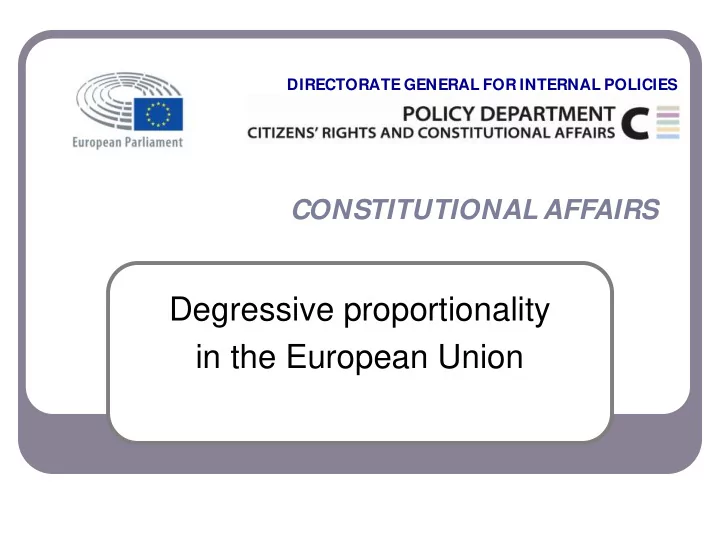

DIRECTORATE GENERAL FOR INTERNAL POLICIES CONSTITUTIONAL AFFAIRS Degressive proportionality in the European Union
Degressive proportionality vs proportionality (apportionment) Proportionality Degressive prop. precisely defined a plethora of options free choice: free choice: • rounding procedure • allocation scheme • rounding procedure
Degressive prop. – an algorithm we have to set three variables: • the number of seats in the EP – S ; • the allocation scheme – A ; • the rounding method – [ ・ ] . the allocation scheme: p (population) → A d ( p) (seats) 𝑶 𝑩 𝒆 𝒒 𝒋 = 𝑻 𝒋=𝟐
Seventy seven allocations Number of seats: Allocation scheme: • • 751 base + prop (CC) • • 678 = 751 – 73 piecewise linear • • optimal size quadratic (parabolic) • • minimum size base + power (MCC) • homographic • linear + hyperbolic Rounding method: • • min-max proportional downward • to the nearest integer • With/without the UK upward
Balanced solutions • some transfer of seats is inevitable • positive : France, the United Kingdom (if applicable), Spain, Estonia • neutral : Germany, Italy, Poland, the Netherlands, Denmark, Finland, Slovakia, Ireland, Croatia, Slovenia, Latvia, Cyprus, Luxembourg, Malta • negative : Romania, Belgium, Greece, the Czech Republic, Portugal, Sweden, Hungary, Austria, Bulgaria, Lithuania • change the status quo as little as possible
Base + power scheme the Modified Cambridge Compromise ( base + power scheme) • expresses more accurately the principle of degressive proportionality • results in the minimum transfer of seats in the EP, (regardless of its size), with the rounding method adjusted to the size • preserving the current size of the EP (751) • reducing the size by all British seats (to 678) • intermediate solution
Smooth transition Brexit: an opportunity to implement a smooth transition to a new balanced allocation system in such a way that each Member State obtains at least the current number of seats in the EP The minimum size of the EP (after Brexit) for which such a smooth solution exists is 721
Population data the exact numbers of MEPs are given in our briefing they are sensitive to the population data we use the based on the Council Decision 2016/2353 of 8 December 2016 decision on the data to be used and the frequency of their updating
Balance of power transition to the MCC system • increases the share of representatives for a few of the largest Member States and reduces it for the medium sized one s a simultaneous modification of the voting system in the Council the Jagiellonian Compromise ( square root weights + optimal quota ) strengthens the voting power of the medium sized states
Presentation by Wojciech Słomczyński, Karol Życzkowski Jagiellonian University Policy Department Citizens’ Rights and Constitutional Affairs Responsible Administrator: Ioannis PAPAGEORGIOU poldep-citizens@europarl.europa.eu
Recommend
More recommend